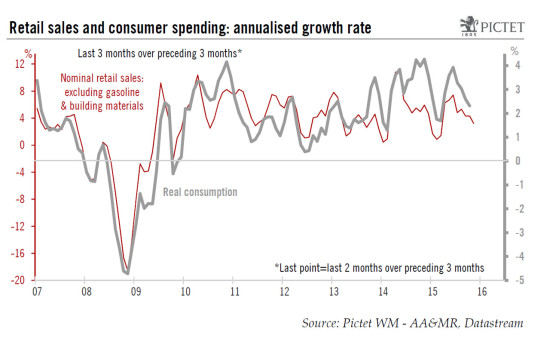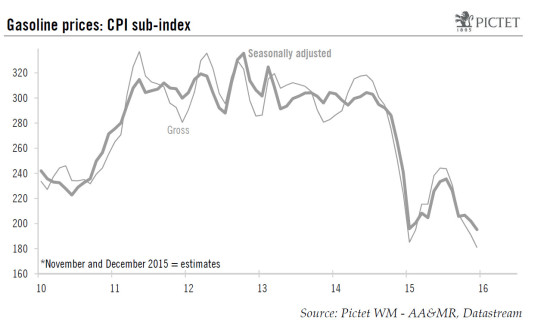Core retail sales rose by a strong 0.6% m-o-m in November, above consensus expectations (+0.4%). Today’s retail sales report was rather upbeat. Although consumption growth can be expected to slow somewhat in Q4, we remain sanguine on overall consumption growth in 2016. Nominal total retail sales increased by 0.2% m-o-m in November, slightly below consensus expectations (+0.3%). Total sales were dented by a 0.8% m-o-m fall in nominal sales at gasoline stations (on the back of lower gasoline prices), a 0.3% drop in sales of building materials and a 0.4% decline in nominal auto sales. This latter decrease was not a surprise as already published data on unit car sales (real) had shown a 0.3% decline m-o-m from the cycle-high reached in October. Control sales: strong monthly increase in November As usual, it is particularly important to look at what has happened to control (core) sales, i.e. sales excluding autos, gasoline and building-materials stores (the portion of retail sales that goes directly into consumption calculations). On that front, November’s results were clearly upbeat. Control sales increased by 0.6% m-o-m, above consensus expectations for a solid 0.4% rise. However, although October’s figure was unrevised (+0.2%), September’s figure was revised down from +0.1% m-o-m to +0.0%.
Topics:
Bernard Lambert considers the following as important: Macroview
This could be interesting, too:
Cesar Perez Ruiz writes Weekly View – Big Splits
Cesar Perez Ruiz writes Weekly View – Central Bank Halloween
Cesar Perez Ruiz writes Weekly View – Widening bottlenecks
Cesar Perez Ruiz writes Weekly View – Debt ceiling deadline postponed
Core retail sales rose by a strong 0.6% m-o-m in November, above consensus expectations (+0.4%).
Today’s retail sales report was rather upbeat. Although consumption growth can be expected to slow somewhat in Q4, we remain sanguine on overall consumption growth in 2016.
Nominal total retail sales increased by 0.2% m-o-m in November, slightly below consensus expectations (+0.3%). Total sales were dented by a 0.8% m-o-m fall in nominal sales at gasoline stations (on the back of lower gasoline prices), a 0.3% drop in sales of building materials and a 0.4% decline in nominal auto sales. This latter decrease was not a surprise as already published data on unit car sales (real) had shown a 0.3% decline m-o-m from the cycle-high reached in October.
Control sales: strong monthly increase in November
As usual, it is particularly important to look at what has happened to control (core) sales, i.e. sales excluding autos, gasoline and building-materials stores (the portion of retail sales that goes directly into consumption calculations). On that front, November’s results were clearly upbeat. Control sales increased by 0.6% m-o-m, above consensus expectations for a solid 0.4% rise. However, although October’s figure was unrevised (+0.2%), September’s figure was revised down from +0.1% m-o-m to +0.0%. The end-result is that between Q3 and October-November, core retail sales grew by a moderate 2.9% annualised, following +4.6% q-o-q in Q3 and +4.3% in Q2.
Today’s retail sales numbers suggest that real consumption growth picked up in November, following a lacklustre reading in October. However, retail sales are measured in nominal terms; they can be very volatile on a monthly basis and they are often revised substantially. And in any case, core retail sales represent only some 25% of total consumption and they have often given a poor indication of overall consumption growth.
We remain sanguine on consumption
Although some improvement seems likely in November, October’s data for total consumption – published two weeks ago – were quite disappointing. They had showed a growth rate between Q3 and October limited to 1.6% annualised. Even after taking on board better forecasted numbers for November and December, consumption growth seems unlikely to top 2.4% in Q4, following +3.0% in Q3. In a context of solid job creation and falling oil prices, this slowdown appears a bit surprising. However, we believe this will prove just a temporary phenomenon.
We remain sanguine on consumption for 2016 overall. Admittedly, employment growth should slow somewhat and the boost to real income that the fall in gasoline prices has implied this year will not be repeated next year. However, job creation will likely remain healthy, whilst wage increases are likely to pick up gradually. And regarding the beneficial effect from the fall in oil prices, a substantial part of this year’s windfall was not spent. In other terms, the saving rate is currently relatively high, and may well fall back next year. Also supportive on that front is the fact that house prices are rising markedly, supporting household wealth. Therefore, we continue to expect healthy consumption growth next year, although it should slow somewhat from the high rate recorded in 2015. On a yearly average basis, we expect consumption growth to settle at a still robust 2.8% in 2015, following 3.1% in 2015.


